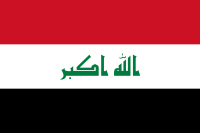Kufi

The Kufic script is one of the oldest calligraphic forms of the Arabic script and is therefore neither a separate script nor an alphabet. It is named after the city of Kufa , which is located in what is now Iraq . Here was a college in which this writing was mainly used by copyists and calligraphers .
A monumental script that runs steeply and geometrically developed early on . Although originally a memorial, it was used for the Koran after the rise of Islam , which remained so until the 10th century . Only in the 12th century did the use of this form of writing as a coin and monumental script decline again.
In the Kufic script, the blending of the individual letters does not go quite as far as in the later Naschī script , which is the most common form of the Arabic script today. In the Kufic script, however, the diacritics (points, Arabic: iʿǧām ) to distinguish letters that look the same, which were first introduced for the Koran at the time of Caliph ' Abd al-Malik ibn Marwan (685-705) , are still missing . This makes the reading of this script even more ambiguous than that of other consonant scripts.
Square kufi
Quadratkufi is a very simplified version of the script that is used in Islamic architecture to decorate tiled facades, for example. The resulting geometric pattern consists of repetitions of names such as Allah, Mohammed and Ali. But also longer texts are sometimes written in square kufi; they are often difficult to decipher.
See also
Web links
- Square Kufic (Square Kufi) - Photos of architectural examples with transliterations

